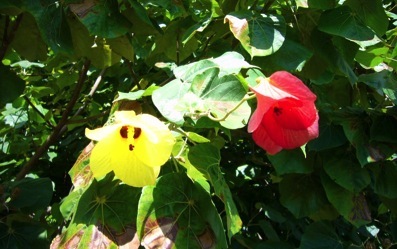Hibiscus tiliaceus: Edible Chameleon
It’s difficult to find a hibiscus you don’t like, including the Mahoe.
In fact, to this writer’s knowledge all hibiscus are edible in some way. They are not all edible in the same way though and the palatability varies greatly. With some it is the flower, others the leaves, sometimes the seed oil only. But, if you have a hibiscus, you have some kind of edible some way.
Like most hibiscus the Mahoe’s blossom lasts only a day. The blossoms stars out yellow but by the end of the day is turning maroon red…. a dynamic flower, and edible, cooked or raw. So are the young leaves, cooked. The roots are edible cooked and the inner bark, the cambium, can be suckled of its moisture and nutrients. The bark can be peeled off in strips and used as is for fishing line. It was also used to make cloth in the Pacific Islands before cotton was made available. And if you use a bow and spindle and spin a hardwood spindle on a baseboard of dry Mahoe, it makes a burning ember for a fire very easily. Actually, the flowers can be boiled like a green or dipped in batter and fried. The leaves can also be fermented into a sauce to make a tempeh starter or boiled in salted water to make a beverage called Onge Tea.
The next reasonable question is why do the blossoms turn color? There are two possible answers that can coexist. One is that the plant is making antioxidants to protect it from the sunlight. The other is the change in color allows the shrub to attract different pollinators who are attracted to different colors. That leads one to infer that flowers collected later in the day may be more beneficial that those collected in the morning.
The botanical name for the Mahoe, Hibiscus tiliaceus (Hye-BISK-us til-ee-AH-see-us) is quite straight forward and not some naughty word play by Carl Linneaus, who started naming plants. Hibiscus is from the Greek word iviscos (ee-VIS-kos) where we get the word viscus and viscosity in English. It means “sticky” because most Hibiscus are mucilaginous. And the species name itself is very sensible. Tiliaceus means like the Tilia, or the Basswood tree (aka Linden tree and Lime tree.) The Mahoe leaves do resemble the Tilia leaves… roughly heart shaped and a very long, pointed tip. Linnaeus got it all right for a change. Mahoe is from the Taino language of the Caribbean and refers to two trees, the Mahoe, and the Blue Mahoe ( Talipariti elatum) the latter a much larger tree.
Don’t confuse the Mahoe with the Milo, or Thespesia populnea, see separate entry. The Mahoe has 9 to 11 prominent veins in the leaf. The Milo has seven. The Mahoe also has dense star-shaped hairs on lower surfaces, the Milo does not. Don’t confuse either with the H. pernambucensis which has solid-yellow flowers, without the dark center.
Green Deane’s “Itemized” Plant Profile
IDENTIFICATION: Shrub to a large tree, tangled growth, in wet areas low branches root in the water, leaves nearly round, Basswood like, short tip, four to eight inches wide, shiny green above, soft, fuzzy gray-green below, flowers cupped 5-petaled, five petals, dark center, yellow turning maroon falling at night or the next morning. Ten-pointed calyx, five seams, seeds hard, brown, 1/8 inch
TIME OF YEAR: Year round in warmer claims, nearly year round in subtropical/temperate areas.
ENVIRONMENT: Coastal hammocks, dunes, damp mainland, landscaping
METHOD OF PREPARATION: The flowers can be boiled like a green or dipped in batter and fried. The leaves boiled like a green or fermented into a sauce to make a tempeh starter. They can be boiled in salted water to make a beverage called Onge Tea. The inner bark is edible as well, though usually suckled. Roast the roots.


